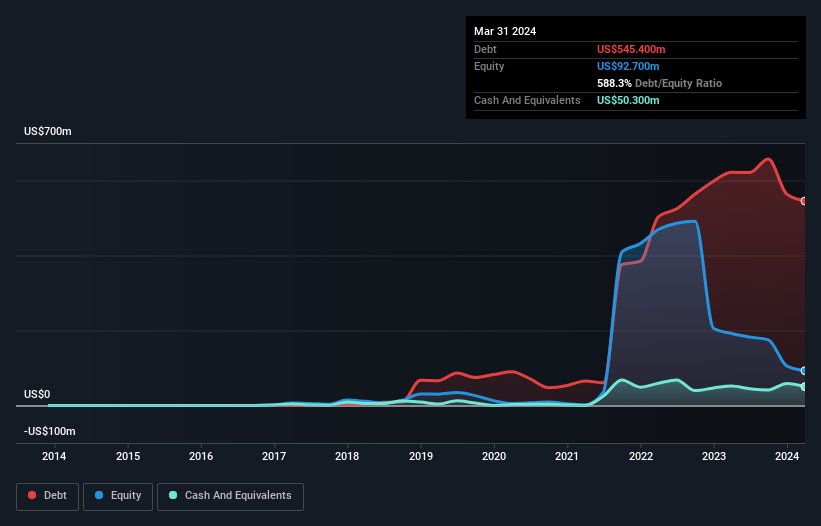- United States
- /
- Specialty Stores
- /
- NasdaqCM:RDNW
Health Check: How Prudently Does RumbleOn (NASDAQ:RMBL) Use Debt?
Warren Buffett famously said, 'Volatility is far from synonymous with risk.' When we think about how risky a company is, we always like to look at its use of debt, since debt overload can lead to ruin. As with many other companies RumbleOn, Inc. (NASDAQ:RMBL) makes use of debt. But the real question is whether this debt is making the company risky.
When Is Debt A Problem?
Debt assists a business until the business has trouble paying it off, either with new capital or with free cash flow. Ultimately, if the company can't fulfill its legal obligations to repay debt, shareholders could walk away with nothing. However, a more common (but still painful) scenario is that it has to raise new equity capital at a low price, thus permanently diluting shareholders. By replacing dilution, though, debt can be an extremely good tool for businesses that need capital to invest in growth at high rates of return. When we examine debt levels, we first consider both cash and debt levels, together.
View our latest analysis for RumbleOn
What Is RumbleOn's Net Debt?
As you can see below, RumbleOn had US$545.4m of debt at March 2024, down from US$621.8m a year prior. On the flip side, it has US$50.3m in cash leading to net debt of about US$495.1m.

How Healthy Is RumbleOn's Balance Sheet?
Zooming in on the latest balance sheet data, we can see that RumbleOn had liabilities of US$411.5m due within 12 months and liabilities of US$394.5m due beyond that. Offsetting these obligations, it had cash of US$50.3m as well as receivables valued at US$33.5m due within 12 months. So its liabilities total US$722.2m more than the combination of its cash and short-term receivables.
This deficit casts a shadow over the US$175.6m company, like a colossus towering over mere mortals. So we definitely think shareholders need to watch this one closely. After all, RumbleOn would likely require a major re-capitalisation if it had to pay its creditors today. The balance sheet is clearly the area to focus on when you are analysing debt. But it is future earnings, more than anything, that will determine RumbleOn's ability to maintain a healthy balance sheet going forward. So if you're focused on the future you can check out this free report showing analyst profit forecasts.
In the last year RumbleOn had a loss before interest and tax, and actually shrunk its revenue by 8.2%, to US$1.3b. That's not what we would hope to see.
Caveat Emptor
Over the last twelve months RumbleOn produced an earnings before interest and tax (EBIT) loss. To be specific the EBIT loss came in at US$3.5m. If you consider the significant liabilities mentioned above, we are extremely wary of this investment. Of course, it may be able to improve its situation with a bit of luck and good execution. But we think that is unlikely, given it is low on liquid assets, and burned through US$56m in the last year. So we consider this a high risk stock and we wouldn't be at all surprised if the company asks shareholders for money before long. The balance sheet is clearly the area to focus on when you are analysing debt. However, not all investment risk resides within the balance sheet - far from it. For example RumbleOn has 2 warning signs (and 1 which is significant) we think you should know about.
If, after all that, you're more interested in a fast growing company with a rock-solid balance sheet, then check out our list of net cash growth stocks without delay.
New: AI Stock Screener & Alerts
Our new AI Stock Screener scans the market every day to uncover opportunities.
• Dividend Powerhouses (3%+ Yield)
• Undervalued Small Caps with Insider Buying
• High growth Tech and AI Companies
Or build your own from over 50 metrics.
Have feedback on this article? Concerned about the content? Get in touch with us directly. Alternatively, email editorial-team (at) simplywallst.com.
This article by Simply Wall St is general in nature. We provide commentary based on historical data and analyst forecasts only using an unbiased methodology and our articles are not intended to be financial advice. It does not constitute a recommendation to buy or sell any stock, and does not take account of your objectives, or your financial situation. We aim to bring you long-term focused analysis driven by fundamental data. Note that our analysis may not factor in the latest price-sensitive company announcements or qualitative material. Simply Wall St has no position in any stocks mentioned.
Have feedback on this article? Concerned about the content? Get in touch with us directly. Alternatively, email editorial-team@simplywallst.com
About NasdaqCM:RDNW
RideNow Group
Provides powersports dealership and vehicle transportation services in the United States.
Good value with low risk.
Market Insights
Community Narratives



